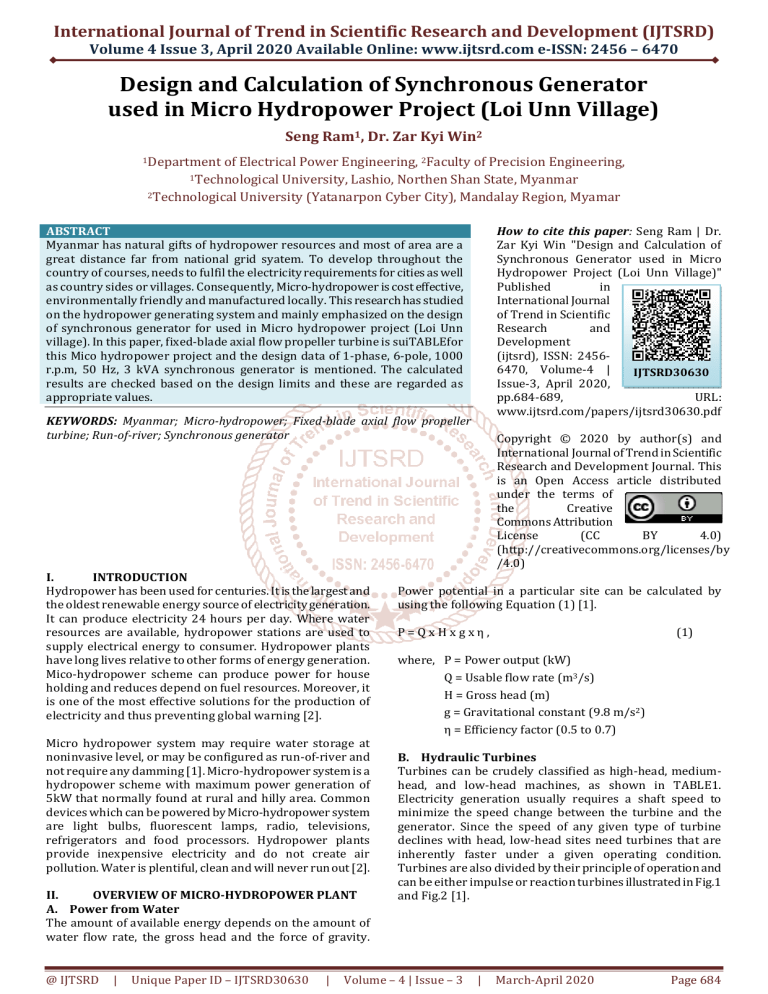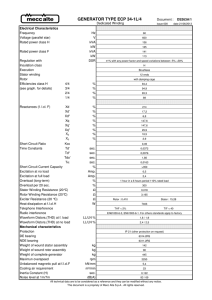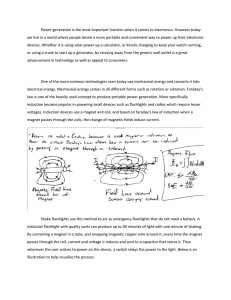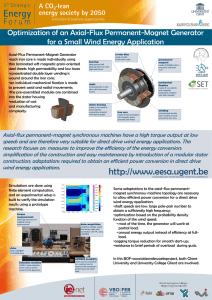
International Journal of Trend in Scientific Research and Development (IJTSRD)
Volume 4 Issue 3, April 2020 Available Online: www.ijtsrd.com e-ISSN: 2456 – 6470
Design and Calculation of Synchronous Generator
used in Micro Hydropower Project (Loi Unn Village)
Seng Ram1, Dr. Zar Kyi Win2
1Department
of Electrical Power Engineering, 2Faculty of Precision Engineering,
1Technological University, Lashio, Northen Shan State, Myanmar
2Technological University (Yatanarpon Cyber City), Mandalay Region, Myamar
ABSTRACT
Myanmar has natural gifts of hydropower resources and most of area are a
great distance far from national grid syatem. To develop throughout the
country of courses, needs to fulfil the electricity requirements for cities as well
as country sides or villages. Consequently, Micro-hydropower is cost effective,
environmentally friendly and manufactured locally. This research has studied
on the hydropower generating system and mainly emphasized on the design
of synchronous generator for used in Micro hydropower project (Loi Unn
village). In this paper, fixed-blade axial flow propeller turbine is suiTABLEfor
this Mico hydropower project and the design data of 1-phase, 6-pole, 1000
r.p.m, 50 Hz, 3 kVA synchronous generator is mentioned. The calculated
results are checked based on the design limits and these are regarded as
appropriate values.
How to cite this paper: Seng Ram | Dr.
Zar Kyi Win "Design and Calculation of
Synchronous Generator used in Micro
Hydropower Project (Loi Unn Village)"
Published
in
International Journal
of Trend in Scientific
Research
and
Development
(ijtsrd), ISSN: 24566470, Volume-4 |
IJTSRD30630
Issue-3, April 2020,
pp.684-689,
URL:
www.ijtsrd.com/papers/ijtsrd30630.pdf
KEYWORDS: Myanmar; Micro-hydropower; Fixed-blade axial flow propeller
turbine; Run-of-river; Synchronous generator
I.
INTRODUCTION
Hydropower has been used for centuries. It is the largest and
the oldest renewable energy source of electricity generation.
It can produce electricity 24 hours per day. Where water
resources are available, hydropower stations are used to
supply electrical energy to consumer. Hydropower plants
have long lives relative to other forms of energy generation.
Mico-hydropower scheme can produce power for house
holding and reduces depend on fuel resources. Moreover, it
is one of the most effective solutions for the production of
electricity and thus preventing global warning [2].
Micro hydropower system may require water storage at
noninvasive level, or may be configured as run-of-river and
not require any damming [1]. Micro-hydropower system is a
hydropower scheme with maximum power generation of
5kW that normally found at rural and hilly area. Common
devices which can be powered by Micro-hydropower system
are light bulbs, fluorescent lamps, radio, televisions,
refrigerators and food processors. Hydropower plants
provide inexpensive electricity and do not create air
pollution. Water is plentiful, clean and will never run out [2].
II.
OVERVIEW OF MICRO-HYDROPOWER PLANT
A. Power from Water
The amount of available energy depends on the amount of
water flow rate, the gross head and the force of gravity.
@ IJTSRD
|
Unique Paper ID – IJTSRD30630
|
Copyright © 2020 by author(s) and
International Journal of Trend in Scientific
Research and Development Journal. This
is an Open Access article distributed
under the terms of
the
Creative
Commons Attribution
License
(CC
BY
4.0)
(http://creativecommons.org/licenses/by
/4.0)
Power potential in a particular site can be calculated by
using the following Equation (1) [1].
P=QxHxgxη,
(1)
where, P = Power output (kW)
Q = Usable flow rate (m3/s)
H = Gross head (m)
g = Gravitational constant (9.8 m/s2)
η = Efficiency factor (0.5 to 0.7)
B. Hydraulic Turbines
Turbines can be crudely classified as high-head, mediumhead, and low-head machines, as shown in TABLE1.
Electricity generation usually requires a shaft speed to
minimize the speed change between the turbine and the
generator. Since the speed of any given type of turbine
declines with head, low-head sites need turbines that are
inherently faster under a given operating condition.
Turbines are also divided by their principle of operation and
can be either impulse or reaction turbines illustrated in Fig.1
and Fig.2 [1].
Volume – 4 | Issue – 3
|
March-April 2020
Page 684
International Journal of Trend in Scientific Research and Development (IJTSRD) @ www.ijtsrd.com eISSN: 2456-6470
TABLE1. TURBINE TYPES BASED ON HEADS
Turbine High-Head Midium-Head Low-Head
Runner
(>50m)
(10-50m)
(<10m)
Pelton
Crossflow
Turgo
Turgo
Impulse
Crossflow
Multi-jet
Multi-jet
Pelton
Pelton
Francis
Properller
Reaction
PAT
Kaplan
(b)
(c)
(d)
Fig.1. Groups of Impulse Turbine:
A. Single-Jet Pelton
B. Multi-Jet Pelton
C. Turgo
D. Crossflow
TABLE3. SELECTION OF GENERATOR
Size of
More than
Up to 10 kW 10 to 25 kW
Scheme
25 kW
Type of
Induction or
Induction or
Generator Synchronous,
Synchronous,
Synchronous,
and
Single or
Three-phase
Three-phase
threephase
Phase
Fig.2. Groups of reaction turbine:
A. Properl
B. Kaplan
C. Francis
Typical efficiency ranges of turbines are given in TABLE2.
Turbines are chosen or are sometimes tail or made
according to site conditions. Selecting the right turbine is one
of the most important parts of designing a hydroelectric
system, and the skills of an engineer are needed in order to
choose the effective turbine for a site, taking into
consideration cost, variations in head, flow, and the amount
of sediment in the water and overall reliability of the turbine
[11].
TABLE2. EFFICIENCY RANGE OF TURBINES
Turbine Type
Efficiency Range
Impulse turbines:
Pelton
80-90%
Turgo
80-95%
Crossflow
65-85%
Reaction turbines:
Francis
80-90%
PAT
60-90%
Propeller
80-95%
Kaplan
80-90%
C. Hydroelectric Generator
Electrical power can be generated in either AC or DC. AC has
the advantage of allowing the use of common household
appliances and tools and is much more economical for
transmitting power to consumers. Thus, AC system is
considered in this study [3]. There are two main types of an
AC generator which are used in hydro-electric scheme. They
are:
|
Unique Paper ID – IJTSRD30630
Synchronous generator and
Induction generator
Criteria for selection of generators are:
Maximum turbine power
Run away speed of turbine
Horizontal or vertical construction
Whether isolated or parallel operation
Constant load or variable load
Availability of grid supply
Reactive power supply
Synchronous generators are standard in electrical power
generation and are used in most power plants.
Asynchronous generators are more commonly known as
induction generators. Both of these generators are available
in three-phase or single-phase systems. And, both machines
may have the same stator design but different rotor design
as illustrated in Fig.4 and Fig.5. The rotor is a rotating part of
a machine. There are two types of the rotor; salient pole type
and cylinder rotor type or non-salient pole rotor type as
shown in Fig.3. System capacity, type of load and length of
the transmission/ distribution net-work dictate whether a
single- or threephase generator should be used [11].
Selection of the generators based on size of scheme and
different between poles and speed are shown in TABLE3 and
TABLE4[1].
(a)
@ IJTSRD
1.
2.
3.
4.
5.
6.
7.
8.
9.
10.
|
TABLE4. DIFFERENT BETWEEN POLES AND SPEED
Number of poles rpm for 50 Hz rpm for 50 Hz
2
3000
3600
4
1500
1800
6
1000
1200
8
750
900
10
600
720
12
500
600
14
429
514
16
375
450
18
333
400
20
300
360
40
150
180
Full load load efficiencies of synchronous generators vary
from 75 to 90 percent, depending on the size of the
generator. Efficiency of induction generator is approximately
75 percent at full load and decreases to as low as 65 percent
at part load [11]. If high portions of loads are likely to be
inductive loads, such as motor and fluorescent lamps, a
synchronous generator is better than an induction generator.
Induction generators in standalone application mode cannot
supply the high-surge power required by motor loads during
start up [1].
Volume – 4 | Issue – 3
Fig.3.Types of Rotors
|
March-April 2020
Page 685
International Journal of Trend in Scientific Research and Development (IJTSRD) @ www.ijtsrd.com eISSN: 2456-6470
There are about 140 houses in Loi Unn village and its
population is about 1000.The location of this village is very
far from the national grid system and the natural resource
for micro-hydropower is existed in this area. So, the
hydropower plants are constructed in Loi Unn village.
Moreover, it is already avoided the uneconomical
transmission system and diesel-electric generation system in
that village. Micro-hydropower plants can be installed at
three possible locations, they are: waterfall, small-dam and
site-channel. In this study, hydropower plants are installed
at a concrete small-dam which is constructed across the Loi
Unn stream as mentioned in the following Fig.7 and Fig.8.
(a)
(b)
Fig.4. Types of Rotor Constrtuction
A. Salient pole rotor
B. Cylindrical-pole rotor (Non salient pole)
Fig.7. Turbine -generator set (Before Inatallation)
(a)
(b)
Fig.5. Different Rotor Design
A. Salient-pole rotor
B. Cylindrical-pole rotors
By using synchronous generator, there is no affection against
grid when parallel running. On the other hand, big overcurrent will rush and voltage drop of grid will occur if
induction generator is applied [5].
III.
MICRO-HYDROPOWER PROJECT (LOI UNN)
The resource of the micro-hydropower is existed at Loi Unn
stream which is located near Loi Unn village which is 0.8 km
far from Kut Kai town in Northern Shan State, Myanmar. Loi
Unn stream is shown in Fig .6.
Fig.8. Loi Unn Micro-Hydropower Project
Total number of turbine-generator sets which are installed
at Loi Unn stream is seven. The capacity of each synchronous
generator is 3kVA. The turbine-generator set is installed in
the concrete spiral casing as shown in the following Fig .9.
Fig.9. Top View of Generator in Spiral casing
The type of each turbine is fixed-blade, axial flow, propeller
type which is included in the group of reaction turbine. The
4-blade propeller runner of Loi Unn project is mentioned in
the following Fig .10.
Fig.6. Loi Unn Stream
@ IJTSRD
|
Unique Paper ID – IJTSRD30630
|
Volume – 4 | Issue – 3
|
March-April 2020
Page 686
International Journal of Trend in Scientific Research and Development (IJTSRD) @ www.ijtsrd.com eISSN: 2456-6470
IV.
DESIGN THEORY OF SYNCHRONOUS GENERATOR
The main parts construction of the 6-pole, synchronous
generator is mentioned in Fig.12. It consists of stator, rotor
and losses. Design of stator has main dimension of stator
frame, stator winding and depth of stator core.
Design of rotor has axial length of pole, width of pole, high of
pole, air-gap length and outer diameter of the rotor. Losses
consist of total losses of stator winding, total iron losses,
total field copper losses, exciter losses and friction and
windage losses [5].
Fig .10. Propeller Runner of Loi Unn Project
The rated speed of the propeller runner is 1000 r.p.m.
According to the theory of synchronous generator, the
number of poles of generator is six-poles. The stator and
salient pole rotor of synchronous generator of Loi Unn
project is shown in Fig .11. The runner of propellers turbine
and the rotor of synchronous generator can be connected
with the same shaft because the speed of two machines are
matched.
Fig.12. Main parts of 6-pole synchronous generator
A. Main Dimension of Stator Frame
Internal diameter and gross length of the stator frame are its
main dimensions. The output equation is the basic tool to
initiate the design of synchronous machine, which relates the
output of the machine with the main dimensions of the
stator [11].
Output of 1-phase synchronous machine,
Q = Kʹ D2Lns,
(2)
where, D - Internal Diameter of the Stator
L - Gross Length of Stator Core
Fig.11. Six-Poles Synchronous Generator
The electrical power generated from seven Micohydropower plants are transmitted to seven houses which
are located at the load-center of Loi Unn village. Voltagedrop problem is overcome by using 3kVA autotransformer at
these seven houses. Then, the electrical power is subtransmitted to other houses from these seven houses. Some
specifications of Loi Unn micro-hydropower project is
mentioned in the following TABLE5.
TABLE5. SPECIFICATIONS OF MICRO-HYDROPOWER
PROJECT (LOI UNN VILLAGE)
Fixed-blade axial flow
Turbine type
propeller
No. of turbine blade
4
Head (h)
3m
Flow rate (q)
0.16 m3/s
Generator drive system
Direct-coupled
Generator type
Salient pole synchronous
Generator capacity
3 kVA
Sypply system
Single-phase A.C
Rated speed
1000 r.p.m
No.of poles of generator
6
Power factor
0.8
Frequency
50 Hz
Voltage
230 V
@ IJTSRD
|
Unique Paper ID – IJTSRD30630
|
Output coefficient of 1-phase synchronous machine,
Kʹ = (11/3) Bav q Kw 10-3
(3)
where, Bav - Specific Magnetic Loading
q - Specific Electric Loading
Kw - Winding Factor
For rectangular poles, the ratio of axial length of the core to
pole pitch varies from 0.8 to 3. A suiTABLEratio may be
assumed for axial length to pole pitch depending upon the
design specifications [5].
L / τP = 0.8 to 3
(4)
Air-gap length,
lg = (0.012 to 0.016) × pole pitch
(5)
B. Design of Stator Winding
Air-gap flux per pole,
φ = Bav τP L
(6)
Number of stators turns per phase,
Tph = Eph / (4.44 f φ Kw)
(7)
Slot pitch
τS = πD / number of stator slots
(8)
Volume – 4 | Issue – 3
|
March-April 2020
Page 687
International Journal of Trend in Scientific Research and Development (IJTSRD) @ www.ijtsrd.com eISSN: 2456-6470
Conductors per slot,
ZS = 2 Tph / number of stator slots
Cross-sectional area of the conductor,
aS = Full-load current / Current density
(9)
D. Regulation
Area of conductor,
Vc =
(28)
(10)
Resistance of field winding,
Number of stator teeth per pole arc,
Nt = Pole arc / τS
Width of stator tooth at air gap surface,
bt = φ / (Bt Lic Nt) ,
(11)
(12)
where, Bt - flux density in the stator tooth
Lic - net iron length of stator core
Width of the stator slot,
bs = τS - bt
(13)
Mean length of the stator winding,
Lmt = 2L + 2.5τP + 0.05 kV + 0.15
(14)
Resistance of the stator winding,
Rs = ρ Lmt Tph/ aS
(15)
Copper losses of stator winding,
Pcus = Iph2 Rph
(16)
Eddy current losses in the stator winding,
Peds = (Kdav - 1) Pcus
(17)
where, Kdav = average loss factor
Total losses of the stator winding,
Pts = Pcus + Peds + Pss
(18)
where, Pss = stay load losses
Effective resistance of the stator winding,
Resistance drop = Iph Rph Kdav
(19)
Depth of stator core,
dc = φc/ Bc Lic
(20)
Outer diameter of the stator core,
Do = D + 2hc + 2dc
(21)
C. Design of Rotor
Air gap length,
Lg = ATg / 0.796 Bg Kg 106
(22)
Rotor diameter,
Dr = D - 2Lg
(23)
Width of the pole,
bp = Ap / Lp
(24)
where Lp = axial length of the pole
Heigh of the pole,
hF =
(25)
Cross-sectional area of the rotor core,
Ac = 0.5 φp / Bc
(26)
Depth of rotor core,
dc = Ac/ Lc
(27)
@ IJTSRD
|
|
Unique Paper ID – IJTSRD30630
RF =
(29)
Copper losses in the field winding,
Pcu,loss = If2 Rf
(30)
Total losses in all the coil,
Ptotal,cu = Pcu,loss pole
(31)
Total field copper losses,
Pt,f = Pcu,loss + Ptotal,cu
(32)
Friction and windage losses = 1% of output
Efficiency,
(33)
η=
(34)
V.
CALCULATED RESULTS
The calculated results of the designed generator are
mentioned in the following TABLE6 to TABLE9.
TABLE6. MAIN DIMENSIONS
Specification
Symbol Unit
Full load output
Q
kVA
Value
3
Line voltage
Number of Phase
Frequency
Speed
Number of poles
Output coefficient
V
f
N
p
Kʹ
Volts
Hz
rpm
-
230
1
50
1000
6
25.282
Internal diameter of stator
Gross length of stator
Peripheral speed
D
L
v
m
m
m/s
0.26
0.11
13.6136
TABLE7. STATOR DESIGN
Specification
Symbol Unit
Value
Flux per phase
φ
Wb 5.69 ×10-3
Turns per phase
Tph
190.64
Conductor per slot
ZS
16
Number of slots
Zs
24
Conductor c.s.a
as
mm2 4.33
Size of conductor
Width of slot
Width of stator tooth
Teeth per pole arc
Depth of slot
Winding Type
bs
bt
Nt
hs
-
Resistance of winding Rph
Effective resistance
Effective reactance
-
Volume – 4 | Issue – 3
|
mm
m
m
m
-
10 × 0.3
0.016
0.018
2.8
0.0116
Double layer, Lap
Ω
p.u
p.u
0.277
0.016
0.04
March-April 2020
Page 688
International Journal of Trend in Scientific Research and Development (IJTSRD) @ www.ijtsrd.com eISSN: 2456-6470
TABLE8. ROTOR DESING
Specification
Symbol
Rotor diagram
Dr
Air-gap length
Lg
Axial length of pole
Lp
Width of pole
bp
Height of pole
hp
Short circuit ratio
SCR
Total no load ampere turns
AT
Full load field ampere turns
ATfl
Sectional area of field conductor af
Field current
If
Field turns per coil
Tf
Resistance of field winding
Rf
Unit
m
m
m
m
m
AT
AT
mm2
A
Ω
Value
0.26
0.0015
0.1
0.049
0.0943
0.9
881
1120
0.266
0.798
1404
18
TABLE9. LOSSES AND EFFICIENCY
Specification
Symbol Unit
Value
Exciter loss
W
8
Copper losses in stator
Pcus
W
46.77
winding
Eddy current losses in
0.9354 ×
Peds
W
conductors
10-3
Stray load losses
Ps
W
7.02
Iron losses
W
106
Rotor copper losses
W
71
Friction & windage losses
W
24
Total full load losses
W
254
Efficiency
η
%
91
VI.
CONCLUSION
Today, rural electrification plays an important role in rural
development. Myanmar has high potential of hydropower
resources. According to the following reasons, rural
electrification recognized as key to rural development.
Therefore, micro-hydropower system is installed at Loi Unn
stream in order to fulfil the requirements of electrical power
of villagers.
This paper mentions the design data of Loi Unn Microhydropower project. 1-phase, 6 pole, 1000 r.p.m, 50 Hz, 3
kVA synchronous generator. Choice of the suiTABLE values
of specific magnetic loading and specific electric loading are
important. Since the designed generator is salient pole
machine, the internal diameter of the stator is larger than the
axial length of the stator core. The length of air gap in
synchronous machines is also an important design
parameter.
Moreover, the number of stator slots should be properly
chosen, as if affects the cost and the performance of
synchronous machine. The flux density in the stator tooth at
the gap surface should not exceed 1.8 Tesla for alternators.
Otherwise, the tooth losses will be excessive. Furthermore,
the choice of the proper value of the current density is also
important. The high current density can be chosen for
economical consideration. But, the resistance of the stator
winding increases, resulting in higher copper loses in the
stator winding, thus reducing the efficiency of the machine.
Usual values for the current density in the stator winding can
be assumed varying from 3 to 5 A/mm2.
@ IJTSRD
|
Unique Paper ID – IJTSRD30630
|
ACKNOWLEDGEMENT
The author is deeply gratitude to Dr. Tin San, Pro-Rector of
Technological University (Lashio) for his instruction. The
author would like to express grateful thanks to her
supervisor Dr. Zar Kyi Win, Faculty of Precision Engineering,
Technological University (Yatanarpon Cyber City), Mandalay
Region, Myamar for her valuable suggestions and
supervision through this research work.
REFRENCES
[1] Dr. Aung Ze Ya “Pico-Hydropower system for Rural
Electrification” in Proceedings of the ICSE 2009
December 2009, Yangon, Myanmar.
[2]
U Aung Ze Ya “Design, Construction and Testing of
Generator for Hydropower Plant” in Proceedings of
the CAFEO 22, December, 2004, Yangon, Myanmar.
[3]
Maung Aung Ze Ya “Design and Construction of Micro
Hydropower Plant” M.E. thesis, Department of
Electrical Power Engineering, Mandalay Technological
University, Mandalay, Myanmar, Feb, 2002.
[4]
Luo Gaorong, Small Hydro Power in China- Experience
and Technology, Hangzhou, China: Hangzhou Regional
Centre, 1996.
[5]
Maung Aung Ze Ya “Design and Construction of
MiniHydropower Plant” Ph.D. thesis, Department of
Electrical Power Engineering, Yangon Tecnological
university, Yangon, Myanmar, Dec, 2004.
[6]
A. Harvey, et al.., Micro-Hydro Design Manual, London,
England: IT Publications Ltd, 1993.
[7]
Abdeen Mustafa Omer “Energy consumption,
development and sustainability in Sudan” Sudan
Engineering Society Journal, vol.52, pp.35-43,
September, 2006.
[8]
Seng Ram, Dr. Zar Kyi Win and Dr. Aung Ze Ya
“Analysis of Parallel Micro-Hydropower Generation
for Rural Electrification (Loi Unn Village)” In
Proceedings of National Conference on Science and
Engineering, Mandalay, Northern Myanmar, (21-22
October, 2010)
[9]
P. K. Nag, Power Plant Engineering, 2nd ed., New
Delhi, India: Tata McGraw-Hill Publishing Company
Limited, 2006.
[10]
British Hydropower Association, A Guide to UK MiniHydro Developments, London, England: BHA, 2005.
[11]
Natural Resources Canada, Micro-Hydropower
Systems, Canada: Natural Resources Canada, 2004.
[12]
Mittle V N. and Mittal A.2000.“Design of Electrical
Machines”. Standard Pub lis ers Distributors. Deli
India.
[13]
R. L. Daughherty, Hydraulic Turbines, 3rd ed., New
York, USA: McGraw-Hill Book Company, 1920.
[14]
A. T. Sayers, Hydraulic and Compressible Flow
Turbomachines, McGraw-Hill International Editions,
Singapore: McGraw-Hill Book Company, 1992
Volume – 4 | Issue – 3
|
March-April 2020
Page 689




